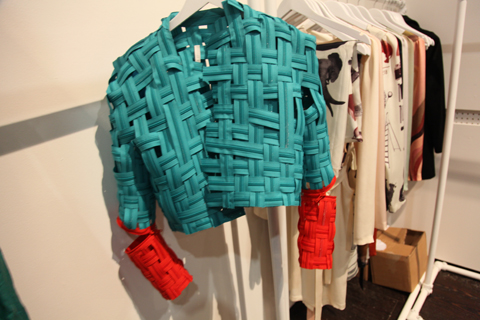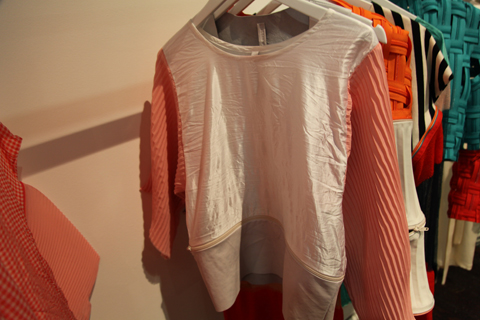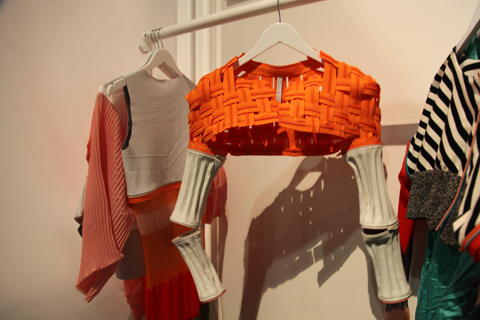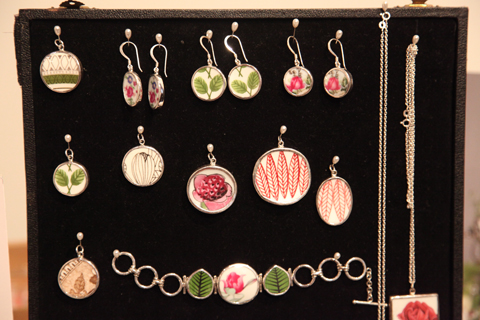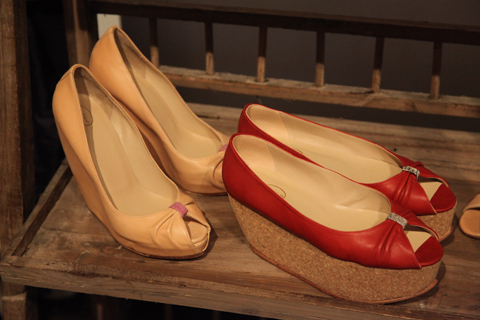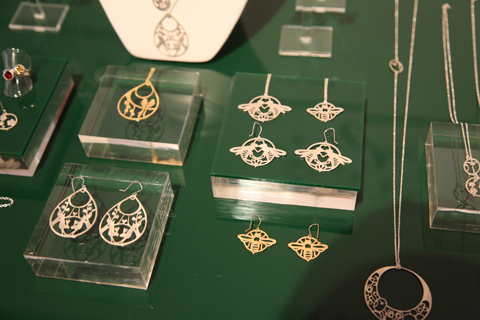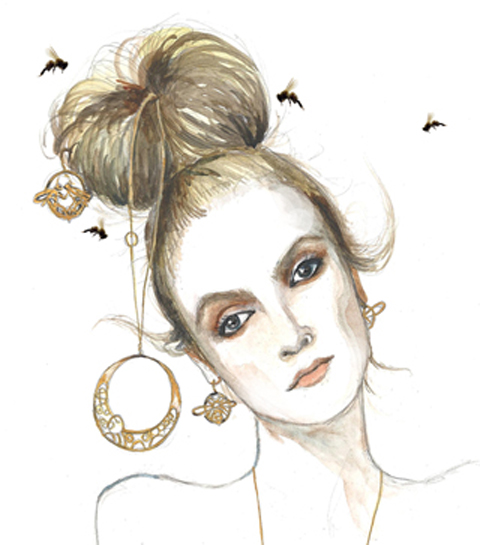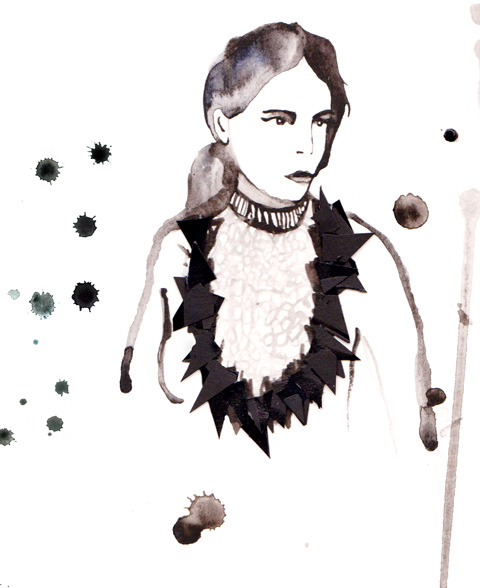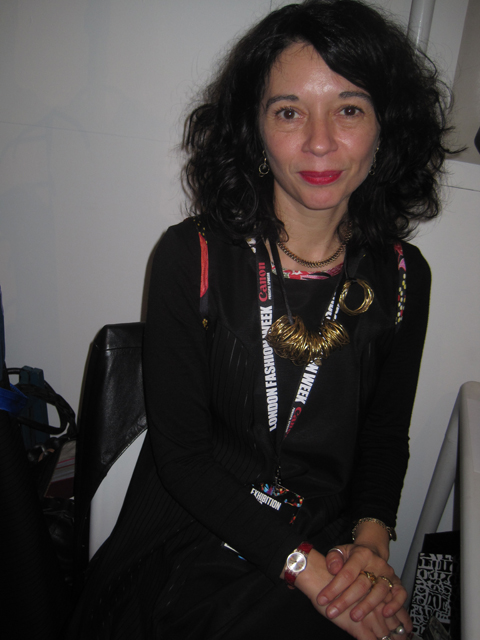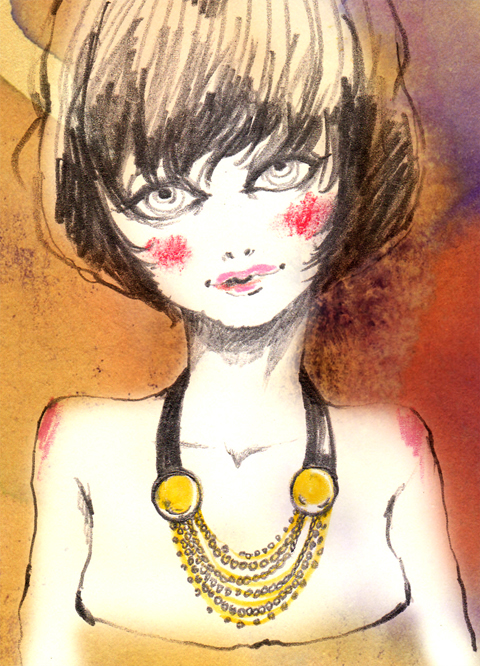
Illustration by Matilde Sazio
“This song is about fucking up against the wall, unhealthy ” Joan Wasser announces to introduce “Hard white wall”, a track from her second album To Survive at her Barbican gig. Never the shrinking violet, Joan is standing in an all-in-one fitted black leather number, slashed at the back, as the spotlights converge on her small frame. Last Sunday was the seventh time I have seen Joan As Police Woman in London.
The first time I saw Joan play was on a balmy summer’s evening in 2006 at now defunct The Spitz in Spitalfields, which in my opinion, used to put on some of the best gigs in London. The venue was at capacity that night and the air inside was clammy to the point where every surface I touched, whether it was a table or wall, seemed to be coated with a film of sweat. Fresh from a tour supporting Guillemots, Joan took the stage in a silver metallic floor length gown and wowed the audience with her electric solo set. No big stage productions, no fancy costume changes, not even a band; just Joan with her powerful, soulful vocals, Korg keyboard and guitar. I am certain that she gained some lifelong fans that night, of which I am one.

The truth is my enthusiasm for Joan extends beyond just liking her records and appreciating her live performances. There’s something about her music – in the same vein as Antony and the Johnsons, Rufus Wainwright, Cat Power and Regina Spektor – which deeply resonates with me. Her sound is raw, honest, pure and sung from the heart in a way which isn’t bland, overdone or contrived. The combination of her emotive vocals, attention to detail in the form of a subtle stroke of cymbal here and an echo of string instruments there, has had the power to reduce me to tears in the past (although I have been known to cry at most things!).
Over the years, Joan has seen me through the best and worst of times: she’s been the soundtrack to exciting train and coach journeys across South East Asia and South America as I have admired the ever-changing landscapes, accompanied me as I have trudged miserably into work on an overheated tube wedged up against some hairy obese man’s armpit, and comforted me through the pain of a relationship break-up where I often found myself lying kidney-bean shaped, feeling sorry for myself (on this last point, what I have learned is that boyfriends may come and go, but if you discover a good artist, they have an unparalleled reliance. Joan has consistently delivered the goods since her first album and that Spitz gig in 2006, which is far more than what can be said of any of my recent relationships).
A multi-instrumentalist who flits effortlessly from piano to guitar to violin, Joan has worked and performed with the likes of Antony and the Johnsons, Rufus Wainwright, Lou Reed, Nick Cave and Elton John to name but a few. Much is made of the fact that she was the girlfriend of the luminous late-Jeff Buckley when he died, whose “Everybody Here Wants You” track is rumoured to be inspired by her, but for Joan to be defined by this alone is grossly unfair. The recognition that she deserves should be based purely on her own talent of epic proportions.
In the same vein as Antony and Rufus, much of Joan’s charm lies in her musical arrangements and unique which can be spine-tingling, served tender or harsh. Her new album, The Deep Field unfurls her lust for life and presents to us a more positive and upbeat individual compared to her earlier offerings, Real Life (2006) and To Survive (2008). In her own words, it is her “most open, joyous record” to date. Although the record is a departure from her more typical sombre sound, its essence is consistent with her previous work where she continues to demonstrate mood, depth, authenticity and sophisticated musical arrangements, which is a rare gem amongst some of the generic, non-memorable cack that passes for music today.
When I meet Joan for tea at the K-West Hotel in Shepherd’s Bush for our interview, she is friendly and upbeat, but appears visibly tired after having spent two days trekking across the UK to do promo work. I try to act cool and calm, but I am sweating like hell and on my way to the hotel, I slip over and land on my bottom to the amusement of two young teenage boys who break out into hysterics, which makes for a nice ice-breaker as I re-tell my story.
Wearing a brown leather jacket, a matching pair of trousers and a bright yellow t-shirt with “Strut ‘n’ Stuff” emblazoned across the front that she picked up from a thrift store, with her thick unkempt dark brown hair and flawless skin, Joan looks much younger than her years – much closer to 30 than 40.
As we sit on a comfy sofa in the library area of the hotel, Joan is oblivious to the two men in suits sitting behind us having a business meeting, who shoot a few disapproving glances in our direction as her voice gets progressively louder over the course of the interview. Speaking animatedly with a cup of herbal tea (she is trying to cut back on the coffee) in one hand and some neatly cut slices of apple in the other, Joan and I discuss life before Joan As Police Woman, the inspiration behind her new record, being in a better place and who’s house she’d most like to be a fly on the wall at, all in the good company of some soft-porn inspired saxophone music, playing softly in the background…
You trained as a classical musician and spent some time performing as one. What was the catalyst for you to explore being an alternative musician?
I always listened to different kinds of music as I was growing up and throughout my classical training. Classical music and non-classical music is all music so for me; it wasn’t all that big of a stretch making other music. I loved studying classical music, but I wasn’t really interested in making it my life’s work because I really wanted to make new music. There were also plenty of people who were better equipped at bringing new insight to the Beethoven violin concerto and I was not one of them. I loved learning the discipline behind that but pursuing a career in it didn’t interest me so when I moved to Boston to go to school I started playing in bands then because all my friends were in bands and the rest, I guess they say, is history.
You’ve been in several bands since you started out as a musician, including playing violin with Rufus Wainwright and Antony and the Johnsons, yet it as only in 2004 that you decided to front your own band. Why was there this delay?
Well I played violin exclusively for some time so I was mostly contributing to other peoples’ bands which I loved doing. I was playing an instrument that is like a voice in itself. You don’t write songs on the violin so I had no way of writing. I picked up a guitar in 1997 to see what it was like; I wanted to figure out if I could write songs and started writing. I put a band together called Black Beetle and wrote a few songs with them and I joined Antony’s band. At this stage, I was still playing with lots of people doing string arranging, but I also wanted to try out my voice which sounded horrible to me at the time. In the beginning you’re not used to what it sounds like and it doesn’t feel natural.
But surely you must have had reassurance from your friends that your voice is anything but horrible…
Well no one heard it. I started playing but I didn’t tell many people. I did get a lot of support from my friends which helped a lot, even if you think they’re lying because they love you.
So it was all very much about stepping slowly out of your comfort zone…
Yes, very much so. Antony had me open with one of his songs solo sometimes. It was a very anxious experience, especially as I was around a lot of astounding vocal performers. It was really scary, but I’m that kind of person where I jump into the deep end. It’s the only way to do things. I was making a record with Black Beetle that never got released, which was part of the learning process and then that band broke up in 2002 but I kept going; playing on my own and then I got a drummer to play with me and then Rufus asked me to go on tour and open for him and it just all went from there.
The first time I saw you perform was at The Spitz in 2006, and even back then you seemed to be a very natural performer. Has performing always been second nature to you?
At that point I felt a lot better. Opening for Rufus (Wainwright) was a good experience – you can’t really be opening for a crowd of total music lovers without getting your act together. Also, the fact that I come to a city that isn’t mine and tonnes of people show up. It makes you feel great; it makes you think: “OK – well at least I’m doing something right”.
When did you start recording the new album and what were your inspirations for the record?
I started by making a covers record which was fun for me to do. I wanted to get out of my head; my own songwriting. I think it really helped me to direct my songwriting on this record. I’m in a great place these days so I feel really open and joyful and I really wanted to get this across in the record. I first recorded seven songs that I had been writing since my last record; some of which I had been playing live, some I hadn’t been. I did that in March and completed those songs and surveyed the scene and decided what the record needed and then spent a few months writing five more songs to fill out the record the way I saw it in June and then mixed the whole thing at the end of last summer. It was really fun because I really had never done that before. Before I would record what I had and decide what it needed and then wrote that kind of song to fit the record so this time, the new approach was a fun exercise for me. I recorded at the same studio with the same producer and I feel very comfortable there; it makes me feel like I’m coming home. And then I just got all of my favourite musicians to contribute to the record. It was just an absolute glorious experience.
How do you think your sound has evolved since Real Life and To Survive?
It’s interesting because when I listen to my songs, I think all the time: “Where did that come from?” It’s beyond me. But I feel like I’m in a different place now…much more relaxed with myself in general. This is one of the treasures of spending more time alive because you get more comfortable with yourself and your surroundings.
You reached a milestone age last summer (Joan turned 40) – were there any anxieties?
I was really excited about it because I felt like it was a demarcation point of where I really didn’t have to give a shit about anything anymore. I never had to before, but I could just actually free myself of all the youth stuff because I have experienced a lot of stuff and it’s really been worth it even though things were very difficult at times. I feel really lucky that everyday feels a bit better than the last day because I’m determined to live a full life.
How did you celebrate?
I had a big party on my roof at home (just outside New York). It was really nice because I was there for the first time on my birthday and I really embraced it.
What advice would you give a 20 year old Joan and 30 year old Joan?
I would just reassure the 20 year old Joan that things are definitely going to get better – I did not think that then. At 30…I don’t know…the thing is I wouldn’t ever do anything differently. You have to learn everything the way you learn them, unfortunately sometimes.
What do you do to switch off?
I definitely have to exercise or I go crazy. I need that in my life so I do that a lot. I spend a certain amount of time with my friends being ridiculous and making jokes as terrible as possible. Oh and drinking way too much coffee.
Who’s house would you most like to be a fly on the wall at?
Prince…definitely! He’s the only person who I think: “What is he doing right now?”. Because you know it’s something weird…or fascinating. He’s just incredible; amazing.
Joan’s new album The Deep Field is out now on PIAS records and she is playing across the UK until 13 February.

Illustration by Matilde Sazio
“This song is about fucking up against the wall, discount ” Joan Wasser announces to introduce “Hard white wall”, adiposity a track from her second album To Survive at her Barbican gig. Never the shrinking violet, recipe Joan is standing in an all-in-one fitted black leather number, slashed at the back, as the spotlights converge on her small frame. Last Sunday was the seventh time I have seen Joan As Police Woman in London.
The first time I saw Joan play was on a balmy summer’s evening in 2006 at now defunct The Spitz in Spitalfields, which in my opinion, used to put on some of the best gigs in London. The venue was at capacity that night and the air inside was clammy to the point where every surface I touched, whether it was a table or wall, seemed to be coated with a film of sweat. Fresh from a tour supporting Guillemots, Joan took the stage in a silver metallic floor length gown and wowed the audience with her electric solo set. No big stage productions, no fancy costume changes, not even a band; just Joan with her powerful, soulful vocals, Korg keyboard and guitar. I am certain that she gained some lifelong fans that night, of which I am one.

Illustration by Darren Fletcher
The truth is my enthusiasm for Joan extends beyond just liking her records and appreciating her live performances. There’s something about her music – in the same vein as Antony and the Johnsons, Rufus Wainwright, Cat Power and Regina Spektor – which deeply resonates with me. Her sound is raw, honest, pure and sung from the heart in a way which isn’t bland, overdone or contrived. The combination of her emotive vocals, attention to detail in the form of a subtle stroke of cymbal here and an echo of string instruments there, has had the power to reduce me to tears in the past (although I have been known to cry at most things!).
Over the years, Joan has seen me through the best and worst of times: she’s been the soundtrack to exciting train and coach journeys across South East Asia and South America as I have admired the ever-changing landscapes, accompanied me as I have trudged miserably into work on an overheated tube wedged up against some hairy obese man’s armpit, and comforted me through the pain of a relationship break-up where I often found myself lying kidney-bean shaped, feeling sorry for myself (on this last point, what I have learned is that boyfriends may come and go, but if you discover a good artist, they have an unparalleled reliance. Joan has consistently delivered the goods since her first album and that Spitz gig in 2006, which is far more than what can be said of any of my recent relationships).

Illustration by Darren Fletcher
A multi-instrumentalist who flits effortlessly from piano to guitar to violin, Joan has worked and performed with the likes of Antony and the Johnsons, Rufus Wainwright, Lou Reed, Nick Cave and Elton John to name but a few. Much is made of the fact that she was the girlfriend of the luminous late-Jeff Buckley when he died, whose “Everybody Here Wants You” track is rumoured to be inspired by her, but for Joan to be defined by this alone is grossly unfair. The recognition that she deserves should be based purely on her own talent of epic proportions.
In the same vein as Antony and Rufus, much of Joan’s charm lies in her musical arrangements and unique which can be spine-tingling, served tender or harsh. Her new album, The Deep Field unfurls her lust for life and presents to us a more positive and upbeat individual compared to her earlier offerings, Real Life (2006) and To Survive (2008). In her own words, it is her “most open, joyous record” to date. Although the record is a departure from her more typical sombre sound, its essence is consistent with her previous work where she continues to demonstrate mood, depth, authenticity and sophisticated musical arrangements, which is a rare gem amongst some of the generic, non-memorable cack that passes for music today.

Illustration by Matilde Sazio
When I meet Joan for tea at the K-West Hotel in Shepherd’s Bush for our interview, she is friendly and upbeat, but appears visibly tired after having spent two days trekking across the UK to do promo work. I try to act cool and calm, but I am sweating like hell and on my way to the hotel, I slip over and land on my bottom to the amusement of two young teenage boys who break out into hysterics, which makes for a nice ice-breaker as I re-tell my story.
Wearing a brown leather jacket, a matching pair of trousers and a bright yellow t-shirt with “Strut ‘n’ Stuff” emblazoned across the front that she picked up from a thrift store, with her thick unkempt dark brown hair and flawless skin, Joan looks much younger than her years – much closer to 30 than 40.
As we sit on a comfy sofa in the library area of the hotel, Joan is oblivious to the two men in suits sitting behind us having a business meeting, who shoot a few disapproving glances in our direction as her voice gets progressively louder over the course of the interview. Speaking animatedly with a cup of herbal tea (she is trying to cut back on the coffee) in one hand and some neatly cut slices of apple in the other, Joan and I discuss life before Joan As Police Woman, the inspiration behind her new record, being in a better place and who’s house she’d most like to be a fly on the wall at, all in the good company of some soft-porn inspired saxophone music, playing softly in the background…

You trained as a classical musician and spent some time performing as one. What was the catalyst for you to explore being an alternative musician?
I always listened to different kinds of music as I was growing up and throughout my classical training. Classical music and non-classical music is all music so for me; it wasn’t all that big of a stretch making other music. I loved studying classical music, but I wasn’t really interested in making it my life’s work because I really wanted to make new music. There were also plenty of people who were better equipped at bringing new insight to the Beethoven violin concerto and I was not one of them. I loved learning the discipline behind that but pursuing a career in it didn’t interest me so when I moved to Boston to go to school I started playing in bands then because all my friends were in bands and the rest, I guess they say, is history.
You’ve been in several bands since you started out as a musician, including playing violin with Rufus Wainwright and Antony and the Johnsons, yet it as only in 2004 that you decided to front your own band. Why was there this delay?
Well I played violin exclusively for some time so I was mostly contributing to other peoples’ bands which I loved doing. I was playing an instrument that is like a voice in itself. You don’t write songs on the violin so I had no way of writing. I picked up a guitar in 1997 to see what it was like; I wanted to figure out if I could write songs and started writing. I put a band together called Black Beetle and wrote a few songs with them and I joined Antony’s band. At this stage, I was still playing with lots of people doing string arranging, but I also wanted to try out my voice which sounded horrible to me at the time. In the beginning you’re not used to what it sounds like and it doesn’t feel natural.

But surely you must have had reassurance from your friends that your voice is anything but horrible…
Well no one heard it. I started playing but I didn’t tell many people. I did get a lot of support from my friends which helped a lot, even if you think they’re lying because they love you.
So it was all very much about stepping slowly out of your comfort zone…
Yes, very much so. Antony had me open with one of his songs solo sometimes. It was a very anxious experience, especially as I was around a lot of astounding vocal performers. It was really scary, but I’m that kind of person where I jump into the deep end. It’s the only way to do things. I was making a record with Black Beetle that never got released, which was part of the learning process and then that band broke up in 2002 but I kept going; playing on my own and then I got a drummer to play with me and then Rufus asked me to go on tour and open for him and it just all went from there.
The first time I saw you perform was at The Spitz in 2006, and even back then you seemed to be a very natural performer. Has performing always been second nature to you?
At that point I felt a lot better. Opening for Rufus (Wainwright) was a good experience – you can’t really be opening for a crowd of total music lovers without getting your act together. Also, the fact that I come to a city that isn’t mine and tonnes of people show up. It makes you feel great; it makes you think: “OK – well at least I’m doing something right”.
When did you start recording the new album and what were your inspirations for the record?
I started by making a covers record which was fun for me to do. I wanted to get out of my head; my own songwriting. I think it really helped me to direct my songwriting on this record. I’m in a great place these days so I feel really open and joyful and I really wanted to get this across in the record. I first recorded seven songs that I had been writing since my last record; some of which I had been playing live, some I hadn’t been. I did that in March and completed those songs and surveyed the scene and decided what the record needed and then spent a few months writing five more songs to fill out the record the way I saw it in June and then mixed the whole thing at the end of last summer. It was really fun because I really had never done that before. Before I would record what I had and decide what it needed and then wrote that kind of song to fit the record so this time, the new approach was a fun exercise for me. I recorded at the same studio with the same producer and I feel very comfortable there; it makes me feel like I’m coming home. And then I just got all of my favourite musicians to contribute to the record. It was just an absolute glorious experience.
How do you think your sound has evolved since Real Life and To Survive?
It’s interesting because when I listen to my songs, I think all the time: “Where did that come from?” It’s beyond me. But I feel like I’m in a different place now…much more relaxed with myself in general. This is one of the treasures of spending more time alive because you get more comfortable with yourself and your surroundings.

You reached a milestone age last summer (Joan turned 40) – were there any anxieties?
I was really excited about it because I felt like it was a demarcation point of where I really didn’t have to give a shit about anything anymore. I never had to before, but I could just actually free myself of all the youth stuff because I have experienced a lot of stuff and it’s really been worth it even though things were very difficult at times. I feel really lucky that everyday feels a bit better than the last day because I’m determined to live a full life.
How did you celebrate?
I had a big party on my roof at home (just outside New York). It was really nice because I was there for the first time on my birthday and I really embraced it.
What advice would you give a 20 year old Joan and 30 year old Joan?
I would just reassure the 20 year old Joan that things are definitely going to get better – I did not think that then. At 30…I don’t know…the thing is I wouldn’t ever do anything differently. You have to learn everything the way you learn them, unfortunately sometimes.
What do you do to switch off?
I definitely have to exercise or I go crazy. I need that in my life so I do that a lot. I spend a certain amount of time with my friends being ridiculous and making jokes as terrible as possible. Oh and drinking way too much coffee.
Who’s house would you most like to be a fly on the wall at?
Prince…definitely! He’s the only person who I think: “What is he doing right now?”. Because you know it’s something weird…or fascinating. He’s just incredible; amazing.
Joan’s new album The Deep Field is out now on PIAS records and she is playing across the UK until 13 February.

Illustration by Matilde Sazio
“This song is about fucking up against the wall, viagra ” announces Joan Wasser to introduce “Hard white wall”, a track from her second album To Survive at her Barbican gig. Never the shrinking violet, Joan is standing in an all-in-one fitted black leather number, slashed at the back, as the spotlights converge on her small frame. Last Sunday was the seventh time I have seen Joan As Police Woman in London.
The first time I saw Joan play was on a balmy summer’s evening in 2006 at now defunct The Spitz in Spitalfields, which in my opinion, used to put on some of the best gigs in London. The venue was at capacity that night and the air inside was clammy to the point where every surface I touched, whether it was a table or wall, seemed to be coated with a film of sweat. Fresh from a tour supporting Guillemots, Joan took the stage in a silver metallic floor length gown and wowed the audience with her electric solo set. No big stage productions, no fancy costume changes, not even a band; just Joan with her powerful, soulful vocals, Korg keyboard and guitar. I am certain that she gained some lifelong fans that night, of which I am one.

Illustration by Darren Fletcher
The truth is my enthusiasm for Joan extends beyond just liking her records and appreciating her live performances. There’s something about her music – in the same vein as Antony and the Johnsons, Rufus Wainwright, Cat Power and Regina Spektor – which deeply resonates with me. Her sound is raw, honest, pure and sung from the heart in a way which isn’t bland, overdone or contrived. The combination of her emotive vocals, attention to detail in the form of a subtle stroke of cymbal here and an echo of string instruments there, has had the power to reduce me to tears in the past (although I have been known to cry at most things!).
Over the years, Joan has seen me through the best and worst of times: she’s been the soundtrack to exciting train and coach journeys across South East Asia and South America as I have admired the ever-changing landscapes, accompanied me as I have trudged miserably into work on an overheated tube wedged up against some hairy obese man’s armpit, and comforted me through the pain of a relationship break-up where I often found myself lying kidney-bean shaped, feeling sorry for myself (on this last point, what I have learned is that boyfriends may come and go, but if you discover a good artist, they have an unparalleled reliance. Joan has consistently delivered the goods since her first album and that Spitz gig in 2006, which is far more than what can be said of any of my recent relationships).

Illustration by Darren Fletcher
A multi-instrumentalist who flits effortlessly from piano to guitar to violin, Joan has worked and performed with the likes of Antony and the Johnsons, Rufus Wainwright, Lou Reed, Nick Cave and Elton John to name but a few. Much is made of the fact that she was the girlfriend of the luminous late-Jeff Buckley when he died, whose “Everybody Here Wants You” track is rumoured to be inspired by her, but for Joan to be defined by this alone is grossly unfair. The recognition that she deserves should be based purely on her own talent of epic proportions.
In the same vein as Antony and Rufus, much of Joan’s charm lies in her musical arrangements and unique which can be spine-tingling, served tender or harsh. Her new album, The Deep Field unfurls her lust for life and presents to us a more positive and upbeat individual compared to her earlier offerings, Real Life (2006) and To Survive (2008). In her own words, it is her “most open, joyous record” to date. Although the record is a departure from her more typical sombre sound, its essence is consistent with her previous work where she continues to demonstrate mood, depth, authenticity and sophisticated musical arrangements, which is a rare gem amongst some of the generic, non-memorable cack that passes for music today.

Illustration by Matilde Sazio
When I meet Joan for tea at the K-West Hotel in Shepherd’s Bush for our interview, she is friendly and upbeat, but appears visibly tired after having spent two days trekking across the UK to do promo work. I try to act cool and calm, but I am sweating like hell and on my way to the hotel, I slip over and land on my bottom to the amusement of two young teenage boys who break out into hysterics, which makes for a nice ice-breaker as I re-tell my story.
Wearing a brown leather jacket, a matching pair of trousers and a bright yellow t-shirt with “Strut ‘n’ Stuff” emblazoned across the front that she picked up from a thrift store, with her thick unkempt dark brown hair and flawless skin, Joan looks much younger than her years – much closer to 30 than 40.
As we sit on a comfy sofa in the library area of the hotel, Joan is oblivious to the two men in suits sitting behind us having a business meeting, who shoot a few disapproving glances in our direction as her voice gets progressively louder over the course of the interview. Speaking animatedly with a cup of herbal tea (she is trying to cut back on the coffee) in one hand and some neatly cut slices of apple in the other, Joan and I discuss life before Joan As Police Woman, the inspiration behind her new record, being in a better place and who’s house she’d most like to be a fly on the wall at, all in the good company of some soft-porn inspired saxophone music, playing softly in the background…

You trained as a classical musician and spent some time performing as one. What was the catalyst for you to explore being an alternative musician?
I always listened to different kinds of music as I was growing up and throughout my classical training. Classical music and non-classical music is all music so for me; it wasn’t all that big of a stretch making other music. I loved studying classical music, but I wasn’t really interested in making it my life’s work because I really wanted to make new music. There were also plenty of people who were better equipped at bringing new insight to the Beethoven violin concerto and I was not one of them. I loved learning the discipline behind that but pursuing a career in it didn’t interest me so when I moved to Boston to go to school I started playing in bands then because all my friends were in bands and the rest, I guess they say, is history.
You’ve been in several bands since you started out as a musician, including playing violin with Rufus Wainwright and Antony and the Johnsons, yet it as only in 2004 that you decided to front your own band. Why was there this delay?
Well I played violin exclusively for some time so I was mostly contributing to other peoples’ bands which I loved doing. I was playing an instrument that is like a voice in itself. You don’t write songs on the violin so I had no way of writing. I picked up a guitar in 1997 to see what it was like; I wanted to figure out if I could write songs and started writing. I put a band together called Black Beetle and wrote a few songs with them and I joined Antony’s band. At this stage, I was still playing with lots of people doing string arranging, but I also wanted to try out my voice which sounded horrible to me at the time. In the beginning you’re not used to what it sounds like and it doesn’t feel natural.

But surely you must have had reassurance from your friends that your voice is anything but horrible…
Well no one heard it. I started playing but I didn’t tell many people. I did get a lot of support from my friends which helped a lot, even if you think they’re lying because they love you.
So it was all very much about stepping slowly out of your comfort zone…
Yes, very much so. Antony had me open with one of his songs solo sometimes. It was a very anxious experience, especially as I was around a lot of astounding vocal performers. It was really scary, but I’m that kind of person where I jump into the deep end. It’s the only way to do things. I was making a record with Black Beetle that never got released, which was part of the learning process and then that band broke up in 2002 but I kept going; playing on my own and then I got a drummer to play with me and then Rufus asked me to go on tour and open for him and it just all went from there.
The first time I saw you perform was at The Spitz in 2006, and even back then you seemed to be a very natural performer. Has performing always been second nature to you?
At that point I felt a lot better. Opening for Rufus (Wainwright) was a good experience – you can’t really be opening for a crowd of total music lovers without getting your act together. Also, the fact that I come to a city that isn’t mine and tonnes of people show up. It makes you feel great; it makes you think: “OK – well at least I’m doing something right”.
When did you start recording the new album and what were your inspirations for the record?
I started by making a covers record which was fun for me to do. I wanted to get out of my head; my own songwriting. I think it really helped me to direct my songwriting on this record. I’m in a great place these days so I feel really open and joyful and I really wanted to get this across in the record. I first recorded seven songs that I had been writing since my last record; some of which I had been playing live, some I hadn’t been. I did that in March and completed those songs and surveyed the scene and decided what the record needed and then spent a few months writing five more songs to fill out the record the way I saw it in June and then mixed the whole thing at the end of last summer. It was really fun because I really had never done that before. Before I would record what I had and decide what it needed and then wrote that kind of song to fit the record so this time, the new approach was a fun exercise for me. I recorded at the same studio with the same producer and I feel very comfortable there; it makes me feel like I’m coming home. And then I just got all of my favourite musicians to contribute to the record. It was just an absolute glorious experience.
How do you think your sound has evolved since Real Life and To Survive?
It’s interesting because when I listen to my songs, I think all the time: “Where did that come from?” It’s beyond me. But I feel like I’m in a different place now…much more relaxed with myself in general. This is one of the treasures of spending more time alive because you get more comfortable with yourself and your surroundings.

You reached a milestone age last summer (Joan turned 40) – were there any anxieties?
I was really excited about it because I felt like it was a demarcation point of where I really didn’t have to give a shit about anything anymore. I never had to before, but I could just actually free myself of all the youth stuff because I have experienced a lot of stuff and it’s really been worth it even though things were very difficult at times. I feel really lucky that everyday feels a bit better than the last day because I’m determined to live a full life.
How did you celebrate?
I had a big party on my roof at home (just outside New York). It was really nice because I was there for the first time on my birthday and I really embraced it.
What advice would you give a 20 year old Joan and 30 year old Joan?
I would just reassure the 20 year old Joan that things are definitely going to get better – I did not think that then. At 30…I don’t know…the thing is I wouldn’t ever do anything differently. You have to learn everything the way you learn them, unfortunately sometimes.
What do you do to switch off?
I definitely have to exercise or I go crazy. I need that in my life so I do that a lot. I spend a certain amount of time with my friends being ridiculous and making jokes as terrible as possible. Oh and drinking way too much coffee.
Who’s house would you most like to be a fly on the wall at?
Prince…definitely! He’s the only person who I think: “What is he doing right now?”. Because you know it’s something weird…or fascinating. He’s just incredible; amazing.
Joan’s new album The Deep Field is out now on PIAS records and she is playing across the UK until 13 February.

Valentines Foxes by Bex Glover.
By now if you have any interest in the upcoming consumer fest that is Valentines Day you will probably already have read Hannah’s slightly bah humbug Valentines blog post, recipe which nevertheless gave some great tips on how to best celebrate this festival of luuuurve.

Peacock Heart by Jenny Lloyd. Available to buy as a print over on Society 6.
Last year I detailed how Valentines has been for me in the past – in almost every instance a non event unless I went to the trouble of sending friends and family something special.

Red Valentine by Jenny Robins. You can buy her Book of Love here on Etsy.
But I’ve been in my current relationship for quite awhile now and this year Valentines Day throws up all sorts of new worries for me… Will he feel pressurised to take me out? Do I even want to go out and join the masses, here now that the option may in fact be available? What do I feel about how I should be treated and what, at the end of the day, is the best expression of love? Don’t laugh, I’ve seriously never had to think about these things before: my love life has been that rubbish for so long.

LSD Love by Natsuki Otani – available to buy online at Society 6.
Well, unsurprisingly I have to say that my views remain pretty much the same as they did last year. For me the best way to show that you care about someone is to put a bit of thought into whatever you decide to do on Valentines Day, whether you are showing that kindness to friends and family or a special partner – something that it goes without saying should really be an ongoing year-round state of affairs.

youmakemetick by Adam Smith.
Whatever you do steer clear of the crazed demands to BUY BUY BUY, and instead think of what your loved one truly appreciates – which is most likely to be your time and your energy. For me receiving something hand made is always the most appreciated gift there is – time having become such a precious resource in itself. There are some really sweet ideas that cost barely a penny over on Hannah’s blog.

Valentines Icecream by Gemma Smith.
Failing that a gift hand made by someone else is definitely a close second best. So in the spirit of collaboration I asked people to send me their hand made Valentines gift ideas via twitter – here’s my pick of the best:

Ankolie has contributed to Amelia’s Magazine as an illustrator – here’s her lovely little Fairy Steps necklace which features really cute heart links and a central cabochon that features one of her paintings, available on Etsy.

Becca Thorne offers this adorable love birds linoprint on Etsy.

On the recycled jewellery front how about this jokey Stay Over toothbrush necklace from Plastic Seconds? Also seen in the ICA shop.

Prick Your Finger offer these lovely knitted wool hearts that were knitted by Mary in the Shetlands: a steal at £4.50

He’s the king of romantic whimsy so I felt duty bound to include the now obligatory Rob Ryan laser cut piece Can We Shall We – miraculously there appear to still be some of these in stock at Soma Gallery. Grab em whilst you can.

Valentines fisheye camera by Gemma Smith.
Lomography have brought out a special edition Diana F+ camera encrusted in naked people and a Fisheye 2 in syrupy sweet pink. If your lover is not yet a hipstamatic aficionado now may might be a good time for them to try analogue again.

I Heart Music by Liz Lewis.
Flowers would never ever go amiss… so long as they haven’t been flown in from some beleaguered country far away.

LOVE by Lou Cloud.
And I like jewellery. Don’t know why. I just do. I think it’s something about the fact that a treasured piece can be worn almost all the time as a reminder of someone’s devotion, which is why I respond very well to delicate pieces… particularly in gold.

Love these rose gold pieces by Laura Gravestock, and quite reasonably priced too.

Peppermint Patty. An oil painting by Artist Andrea.
Speaking of which, the much anticipated UK Fairtrade ethical gold standard came into force only yesterday, so here’s hoping that it will soon become very much easier to buy luxury jewellery that is made without harm to people or planet. Because, after all, where’s the love in that?

Over at EC One ethical jewellery brand Oria (featured in Amelia’s Compendium of Fashion Illustration) offer their lovely lovebird earrings – as illustrated in my book. Purrrrfect, and they come with a totally clear conscience.
Finally, if you’re looking for something to do that’s a bit out of the ordinary, how about a trip to the Museum of Everything to see the current Peter Blake curated exhibition for the last time? There will be things to watch all over the weekend, including live music, and a film showing.

Je t’aime by Anieszka Banks.
The School for Life is well known for hosting some ever so intriguing seminars. On February 14th they ask:
Who’d be in a relationship?
At its best, love can make us deliriously happy. At worst, it makes us more miserable than anything on earth. It robs us of our autonomy, freedom and financial independence. It can bring disillusion, heartbreak and betrayal.
Who’d be single?
We’re confined to the prison of our established and frequently very boring selves. At best, singleness allows us to be free agents, able to fulfill our desires. At worst, it drags us down to the depths of loneliness. It robs us of intimacy, personal engagement, and an understanding that true happiness is about giving oneself away.

Paris by Joana Faria.
So why not book an evening with author Simon Critchley? He’ll be talking at The School for Life which is located at 70 Marchmont Street, London WC1N 1AB.

And if you’re still feeling a bit grumpy about the whole affair how about this free downloadable Zombie Valentines lino cut from Quinky Art?
No pressure on the boyfriend at all then. But between this lot there’s a little something for everyone don’t you think? Especially the ladies amongst us…

Oria Lovebird necklace as featured in Amelia’s Compendium of Fashion Illustration. Illustration by Emma Block.
You can read more about my abysmal love life in my Valentines blog post from 2010.
Categories ,ACOFI, ,Adam Smith, ,Amelia’s Compendium of Fashion Illustration, ,Andrea Peterson, ,Anieszka Banks, ,Ankolie, ,Artist Andrea, ,Becca Thorne, ,Bex Glover, ,Can We Shall We, ,Diana F+, ,EC One, ,Emma Block, ,Ethical Gold, ,etsy, ,fairtrade, ,Fisheye 2, ,Flowers, ,Gemma Smith, ,gifts, ,Gold, ,hearts, ,ica, ,Je t’aime, ,Jenny Lloyd, ,Jenny Robins, ,jewellery, ,Joana Faria, ,Laura Gravestock, ,Liz Lewis, ,Lou Cloud, ,Museum of Everything, ,Natsuki Otani, ,Oria, ,Peacock Heart, ,Peter Blake, ,Plastic Seconds, ,Prick your Finger, ,Quinky Art, ,rob ryan, ,Simon Critchley, ,Society 6, ,Soma Gallery, ,The School of Life, ,Valentine’s Day
Similar Posts:
- Valentines Day 2013: Card Ideas and Prints for Gifts
- Valentines Day 2013: Jewellery, Handmade Gifts & Discounts on Chocolates
- Valentines Day: Last Minute Ideas
- Valentine’s Day Gift Ideas by Designer Makers: 2014
- Valentine’s Day

![LFW_[CarolynMassey2]_AnnejkhCarson](http://www.ameliasmagazine.com/wp-content/uploads/2010/10/LFW_CarolynMassey2_AnnejkhCarson.jpg)

